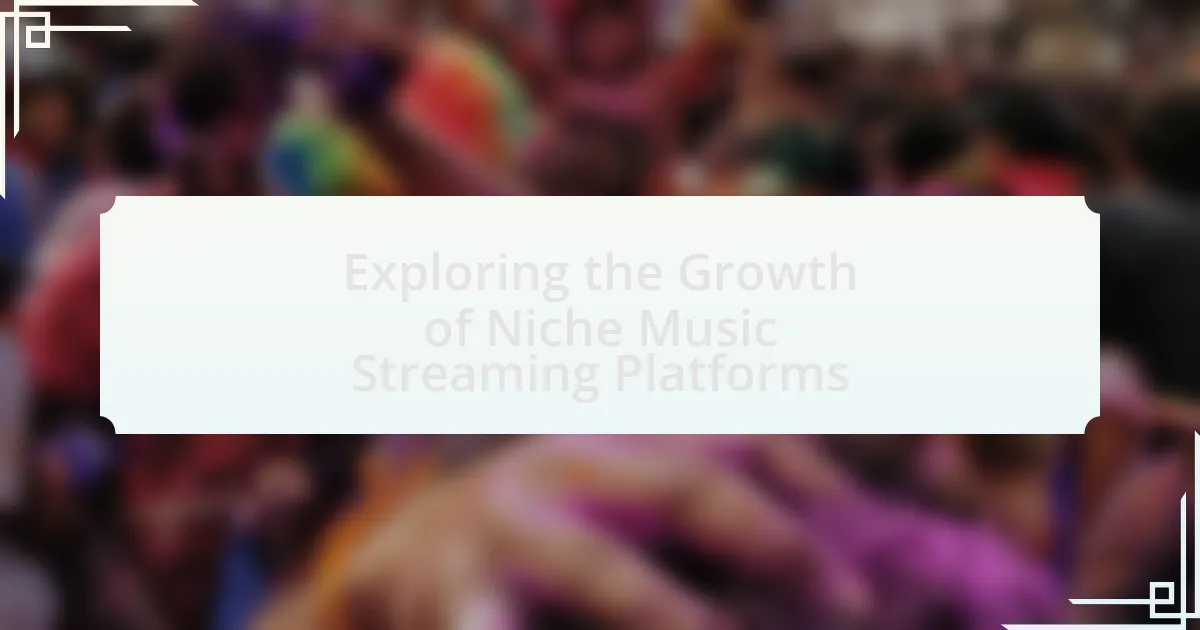Niche music streaming platforms are specialized services that focus on specific genres, audiences, or musical preferences, distinguishing themselves from mainstream platforms like Spotify and Apple Music. This article explores the characteristics of these platforms, including their unique content curation, community engagement, and the challenges they face, such as licensing issues and competition from larger services. It also examines the growing consumer interest in personalized music experiences and the trends driving the expansion of niche platforms, as well as the financial and technological strategies they can adopt for sustainability and growth in the evolving music streaming market.

What are Niche Music Streaming Platforms?
Niche music streaming platforms are specialized services that cater to specific genres, audiences, or musical preferences, distinguishing themselves from mainstream platforms like Spotify or Apple Music. These platforms often focus on particular music styles, such as classical, jazz, or indie, and provide curated content, community features, and unique user experiences tailored to their target demographics. For example, platforms like Bandcamp allow independent artists to sell their music directly to fans, while services like Tidal emphasize high-fidelity audio quality and artist-centric revenue models. The growth of these platforms reflects a rising demand for personalized music experiences and a shift towards supporting independent artists.
How do niche music streaming platforms differ from mainstream services?
Niche music streaming platforms differ from mainstream services primarily in their focus on specific genres or communities. While mainstream services like Spotify and Apple Music offer a broad catalog of popular music across various genres, niche platforms such as Bandcamp or SoundCloud cater to particular audiences, often emphasizing independent artists and specialized genres. For instance, Bandcamp allows artists to sell their music directly to fans, fostering a closer connection between creators and listeners, which is less emphasized in mainstream services. This targeted approach enables niche platforms to curate unique content and foster dedicated communities, contrasting with the algorithm-driven playlists of mainstream services that prioritize mass appeal.
What specific genres or audiences do niche platforms cater to?
Niche platforms cater to specific genres such as indie, classical, jazz, electronic, and world music, as well as targeted audiences like audiophiles, genre enthusiasts, and cultural communities. These platforms focus on delivering curated content that appeals to listeners with distinct musical tastes, often providing features that enhance the listening experience for these specific groups. For instance, platforms like Bandcamp emphasize independent artists and niche genres, while services like Classical Archives specialize in classical music, catering to audiences seeking in-depth exploration of these genres.
How do niche platforms curate their music selections?
Niche platforms curate their music selections through a combination of algorithmic recommendations and human curation. These platforms often utilize data analytics to understand listener preferences, analyzing factors such as listening history, user interactions, and genre trends. For instance, platforms like Bandcamp and SoundCloud rely on user-generated content and community feedback to highlight emerging artists and specific genres, ensuring that their selections resonate with targeted audiences. Additionally, expert curators or genre specialists may create playlists that reflect the unique tastes of the platform’s user base, further enhancing the personalized experience. This dual approach of leveraging technology alongside human insight allows niche platforms to maintain a distinct musical identity while catering to the specific interests of their listeners.
Why is there a growing interest in niche music streaming platforms?
There is a growing interest in niche music streaming platforms due to their ability to cater to specific musical tastes and communities. These platforms often provide curated content that aligns closely with the preferences of their target audiences, enhancing user engagement and satisfaction. For instance, platforms like Bandcamp and SoundCloud allow independent artists to reach dedicated fan bases, fostering a sense of community and connection that mainstream services may lack. Additionally, the rise of personalized algorithms and user-driven content has made it easier for listeners to discover unique genres and underground artists, further driving the appeal of niche platforms.
What trends are driving the growth of these platforms?
The growth of niche music streaming platforms is primarily driven by the increasing demand for personalized music experiences. Consumers are seeking tailored content that aligns with their specific tastes and preferences, leading to the rise of platforms that cater to distinct genres or communities. For instance, platforms like Bandcamp and SoundCloud have gained popularity by allowing independent artists to connect directly with their audiences, fostering a sense of community and exclusivity. Additionally, the shift towards mobile consumption and the integration of social features have enhanced user engagement, further propelling the growth of these platforms. According to a report by Statista, the global music streaming market is projected to reach $23.5 billion by 2023, indicating a significant trend towards digital consumption and the viability of niche offerings within this expanding market.
How has consumer behavior shifted towards niche music consumption?
Consumer behavior has shifted towards niche music consumption due to the rise of specialized streaming platforms that cater to specific genres and communities. This shift is evidenced by the increasing popularity of platforms like Bandcamp and SoundCloud, which allow independent artists to reach targeted audiences, resulting in a 30% growth in niche music sales from 2019 to 2022. Additionally, listeners are increasingly seeking personalized experiences, with 70% of consumers expressing a preference for curated playlists that reflect their unique tastes, as reported by a 2023 Nielsen study. This trend indicates a significant move away from mainstream music consumption towards more tailored and diverse musical offerings.

What challenges do niche music streaming platforms face?
Niche music streaming platforms face significant challenges including limited user bases, competition from mainstream services, and difficulties in monetization. Limited user bases restrict revenue potential, as these platforms often cater to specific genres or communities, resulting in fewer subscribers compared to larger competitors like Spotify or Apple Music. Competition from mainstream services makes it hard for niche platforms to attract and retain users, as these larger platforms offer extensive libraries and advanced features. Additionally, monetization challenges arise from the need to balance subscription fees with user expectations for affordable access to content, often leading to reliance on advertising or partnerships that may not be sustainable.
How do licensing and copyright issues impact niche platforms?
Licensing and copyright issues significantly impact niche platforms by determining the availability of content and the operational costs associated with it. Niche music streaming platforms often rely on specific licensing agreements to legally distribute music, which can limit their catalog and affect user engagement. For instance, platforms focusing on independent or genre-specific music may face challenges in securing licenses from major record labels, leading to a restricted selection of tracks. Additionally, the costs associated with obtaining these licenses can strain the financial resources of smaller platforms, making it difficult for them to compete with larger services that have more negotiating power. According to a report by the International Federation of the Phonographic Industry, smaller platforms often struggle with the high percentage of revenue that must be allocated to licensing fees, which can reach up to 70% of their earnings. This financial burden can hinder their growth and sustainability in the competitive streaming market.
What are the common legal hurdles for niche music streaming services?
Niche music streaming services commonly face legal hurdles such as copyright infringement, licensing agreements, and regulatory compliance. Copyright infringement arises when these platforms fail to secure the necessary rights to stream music, leading to potential lawsuits from rights holders. Licensing agreements are crucial, as niche services must negotiate terms with record labels and artists to legally distribute their content; failure to do so can result in hefty fines or shutdowns. Additionally, regulatory compliance with local and international laws, including data protection and consumer rights, poses challenges that can complicate operations and increase costs. These legal issues are significant barriers that can hinder the growth and sustainability of niche music streaming platforms.
How do these challenges affect the availability of content?
Challenges such as licensing issues, market competition, and technological barriers significantly reduce the availability of content on niche music streaming platforms. Licensing issues can limit the range of music that platforms can legally offer, as they must negotiate rights with artists and record labels, which can be a lengthy and costly process. Market competition from larger streaming services often leads to a focus on mainstream content, making it difficult for niche platforms to secure diverse catalogs. Additionally, technological barriers, including inadequate infrastructure or lack of investment in content delivery systems, can hinder the ability of these platforms to provide a seamless user experience, further affecting content availability.
What financial obstacles do niche platforms encounter?
Niche platforms encounter several financial obstacles, primarily limited revenue streams and high operational costs. These platforms often struggle to monetize their offerings effectively due to a smaller user base compared to mainstream services, which results in lower subscription and advertising revenues. For instance, a report by PwC indicates that niche streaming services typically generate less than 10% of the revenue of major platforms like Spotify, making it challenging to cover costs associated with licensing, technology, and marketing. Additionally, niche platforms may face difficulties in securing funding, as investors often prefer to back larger, more established companies with proven profitability.
How do revenue models differ between niche and mainstream platforms?
Revenue models differ significantly between niche and mainstream platforms primarily due to their target audiences and content offerings. Niche platforms often rely on subscription-based models, where users pay a monthly fee for specialized content, catering to specific genres or communities, such as indie music or classical music. For example, platforms like Bandcamp allow artists to set their own prices, directly supporting creators and fostering a dedicated user base.
In contrast, mainstream platforms typically utilize ad-supported models alongside subscription options, aiming to attract a broader audience. Services like Spotify and Apple Music offer free tiers funded by advertisements, which generate revenue from a larger user base, while also providing premium subscriptions for an ad-free experience. This dual approach allows mainstream platforms to maximize revenue through both advertising and subscriptions, capitalizing on their extensive reach.
The differences in revenue models reflect the distinct strategies employed by niche and mainstream platforms to engage their respective audiences and monetize their services effectively.
What strategies can niche platforms use to sustain profitability?
Niche platforms can sustain profitability by implementing targeted subscription models, enhancing user engagement through personalized content, and leveraging partnerships with artists and brands. Targeted subscription models allow platforms to cater to specific audiences, which can lead to higher conversion rates; for instance, platforms like Bandcamp have successfully utilized this approach by offering artists a share of revenue, thus attracting a dedicated user base. Enhancing user engagement through personalized content, such as curated playlists and recommendations, increases user retention, as evidenced by Spotify’s algorithm-driven features that keep users active on the platform. Additionally, forming partnerships with artists and brands can create exclusive content and promotional opportunities, driving both user interest and revenue; for example, platforms like Tidal have collaborated with artists for exclusive releases, which not only boosts subscriptions but also enhances brand loyalty.

What are the future prospects for niche music streaming platforms?
Niche music streaming platforms are expected to experience significant growth in the future due to increasing consumer demand for specialized content. As listeners seek unique genres and personalized experiences, platforms that cater to specific musical tastes, such as classical, indie, or regional music, are likely to attract dedicated user bases. According to a report by Statista, the global music streaming market is projected to reach $76.9 billion by 2027, with niche platforms capturing a growing share as they offer tailored services that mainstream platforms may overlook. This trend indicates a promising future for niche music streaming platforms as they capitalize on the desire for diversity and authenticity in music consumption.
How might technology influence the evolution of niche platforms?
Technology significantly influences the evolution of niche platforms by enabling personalized user experiences and enhancing content discovery. Advanced algorithms and machine learning techniques allow these platforms to analyze user preferences and behaviors, tailoring recommendations to individual tastes. For instance, Spotify’s use of data analytics to create personalized playlists has been pivotal in attracting and retaining users, demonstrating how technology can drive engagement. Additionally, the rise of cloud computing facilitates seamless streaming and storage, allowing niche platforms to offer extensive libraries without the need for significant infrastructure investment. This technological advancement supports the growth of specialized music genres, catering to specific audiences and fostering community engagement.
What role will artificial intelligence play in music curation?
Artificial intelligence will play a pivotal role in music curation by enhancing personalization and improving user experience on niche music streaming platforms. AI algorithms analyze user listening habits, preferences, and contextual data to create tailored playlists and recommendations, thereby increasing user engagement. For instance, platforms like Spotify and Apple Music utilize machine learning techniques to refine their recommendation systems, which has been shown to significantly boost user retention rates. According to a study by the International Journal of Information Management, personalized recommendations can increase user satisfaction by up to 30%, demonstrating the effectiveness of AI in curating music that resonates with individual listeners.
How can niche platforms leverage data analytics for growth?
Niche platforms can leverage data analytics for growth by utilizing user behavior insights to tailor content and enhance user engagement. By analyzing data such as listening habits, demographic information, and user feedback, these platforms can identify trends and preferences specific to their audience. For instance, a study by Deloitte found that personalized recommendations can increase user retention by up to 30%. Additionally, niche platforms can optimize marketing strategies by targeting specific user segments based on data-driven insights, leading to more effective campaigns and higher conversion rates. This strategic use of data analytics not only fosters user loyalty but also drives revenue growth through targeted advertising and subscription models.
What strategies can niche music streaming platforms adopt for success?
Niche music streaming platforms can achieve success by focusing on targeted content curation, community engagement, and personalized user experiences. Targeted content curation allows these platforms to cater to specific genres or demographics, attracting dedicated listeners who seek unique offerings. For instance, platforms like Bandcamp have thrived by emphasizing independent artists and niche genres, which fosters a loyal user base.
Community engagement is crucial; platforms can create forums or social features that encourage interaction among users and artists, enhancing user retention. Research indicates that platforms with strong community ties see higher user satisfaction and loyalty.
Additionally, personalized user experiences, such as tailored playlists and recommendations based on listening habits, can significantly improve user engagement. According to a study by MIDiA Research, personalized recommendations can increase user retention rates by up to 30%. By implementing these strategies, niche music streaming platforms can effectively differentiate themselves in a competitive market.
How can niche platforms enhance user engagement and loyalty?
Niche platforms enhance user engagement and loyalty by providing tailored content that meets specific interests and preferences of their users. These platforms often curate playlists, recommend artists, and create communities around particular genres or themes, fostering a sense of belonging among users. For instance, a study by MIDiA Research found that niche music streaming services can achieve higher user retention rates, with some platforms reporting up to 30% more loyalty compared to mainstream services, as users feel more connected to the content that resonates with their unique tastes. This targeted approach not only increases user satisfaction but also encourages active participation, such as sharing playlists and engaging in discussions, further solidifying their loyalty to the platform.
What marketing tactics are effective for reaching niche audiences?
Effective marketing tactics for reaching niche audiences include targeted social media advertising, influencer partnerships, and content marketing tailored to specific interests. Targeted social media advertising allows brands to reach specific demographics based on interests, behaviors, and location, which is crucial for niche markets. For instance, platforms like Facebook and Instagram offer advanced targeting options that can help brands connect with users who have specific music preferences. Influencer partnerships leverage the credibility and reach of individuals who resonate with niche audiences, enhancing brand visibility and trust. Content marketing, such as blogs, podcasts, or videos that focus on niche topics, engages audiences by providing value and fostering community. According to a study by HubSpot, 70% of marketers actively invest in content marketing, highlighting its effectiveness in engaging targeted audiences.
What are the best practices for launching a niche music streaming platform?
The best practices for launching a niche music streaming platform include identifying a specific target audience, curating unique content, ensuring a user-friendly interface, implementing effective marketing strategies, and leveraging data analytics for continuous improvement. Identifying a specific target audience allows the platform to tailor its offerings to meet the distinct preferences of that group, which can enhance user engagement. Curating unique content, such as exclusive tracks or artist interviews, differentiates the platform from mainstream services and attracts dedicated listeners. A user-friendly interface is crucial for retaining users, as studies show that 88% of online consumers are less likely to return to a site after a bad experience. Effective marketing strategies, including social media campaigns and partnerships with influencers, can increase visibility and attract new users. Finally, leveraging data analytics helps in understanding user behavior and preferences, enabling the platform to adapt and improve its offerings over time.

Leave a Reply